|
Duomo - San Romolo
Piazza Mino da Fiesole |
|
The word duomo comes from the Latin domus, meaning the house
of the Lord. So nothing to do with domes.
History
Founded 1028 to replace the old cathedral which was where the Badia
Fiesolana is currently sited. Enlarged from 1256, which work took about a
century. Heavily restored 1878-83, the (spoiled?) appearance of the
exterior dating to this work. Romulus is the patron saint of Fiesole and
was probably a bishop in the 1st century. Tradition has it that he
was a disciple of Saint Peter, that he had been converted to
Christianity by the apostle and that he was the first bishop of Fiesole.
Interior
Dark on entering due to the windows being few and thin, but this makes the
highlight high altarpiece glow and dominate. Nine chunky columns down each side
of the nave, the first five corinthians, the next four of plainer design.
The
walls are bare with only confessionals breaking up their flatness. Baroque
altars were removed during the 19th century work. The inner facade has a glazed terracotta
of
Saint
Romulus himself made by Giovanni della Robbia (the grandnephew of
Luca) for a different church. The noticeable high altar in
grey-green and white marble dates from 1273.
There's a raised choir with stairs up to each side, each side being
self-enclosed. The left-hand side has a 19th century
pseudo-gothic altarpiece, the right-hand side has another such, but also two decorated
side chapels, and the best view of the impressive Bicci di Lorenzo high altarpiece.
The right-hand of the two small chapels is the Capella Salutati (see
below right) with the vault frescoed with The Four Evangelists by
Cosimo Roselli and two fine sculptures by Mino da Fiesole - the tomb of
Bishop Leonardo Salutati on the right and an altar frontal of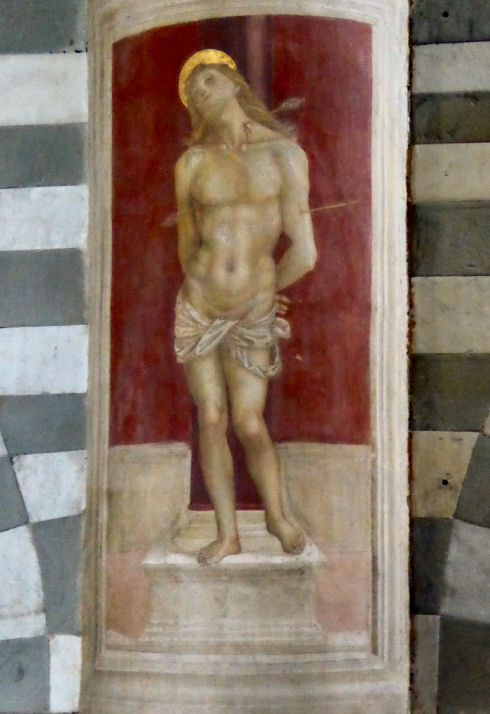 the
Virgin and Saints on the left. the
Virgin and Saints on the left.
The high altarpiece in the choir is a triptych depicting the
Virgin
and Child with Saints Alexander, Peter, Romulus and Donatus painted
by Bicci di Lorenzo in the 1440s. This work has the earliest known
representation of Romulus. The apse vault was frescoed with scenes
from the life of St Romulus by Nicodemo Ferrucci in the early 17th century
The crypt below the choir has a statue of the Virgin as you enter on the left
and a granite baptismal font of 1569 on the right, the work of Francesco Ferucci, with frescoed domes. Down here are most of the remains from the
first church. The
central altar of Saint Romulus houses his relics in a marble urn. It is fenced off
with Roman remains under grills in the floor in front. There are frescos on
the columns by the entrances to the crypt too, one of Saint Benedict
from around 1420–30 and a later Saint Sebastian (see right) sometimes locally,
and unconvincingly, said to be by Perugino.
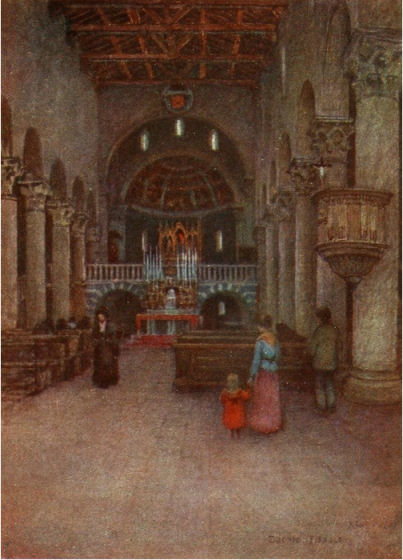 Campanile Campanile
Built 1213 and much restored, with the balcony added in 1738 and restored
in the 19th century.
The church in art
There's a late-19th-century interior view
by Fabio Borbottoni (see below) which may well have been made before the restoration
work, as details look different. Also
several later views of the interior (see right) by R. C. Goff in his book
Florence and Some Tuscan Cities.
Opening times
7.30-12.00, 3.00- 6.00
(2.00-5.00 in winter)
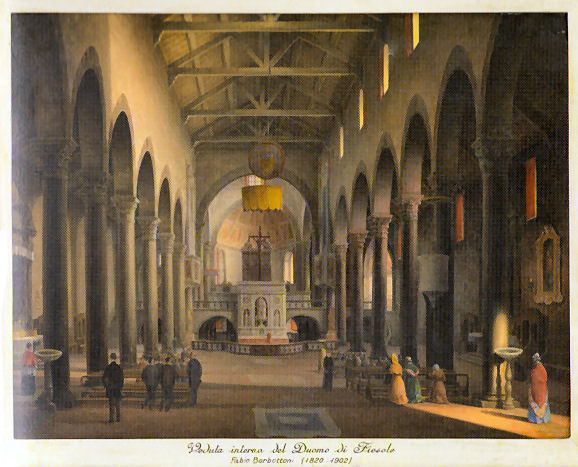
|
|
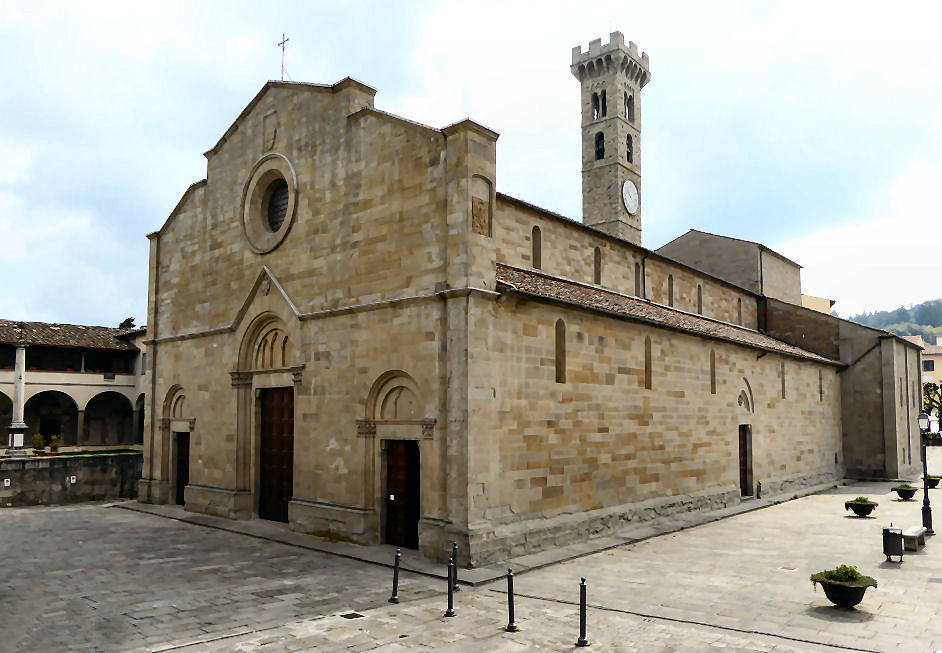
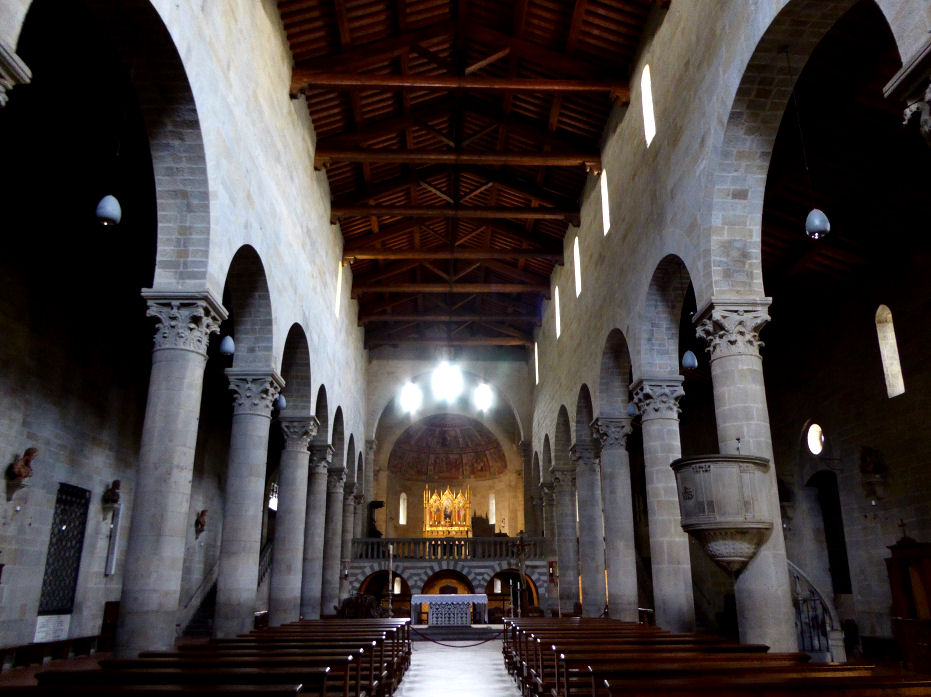
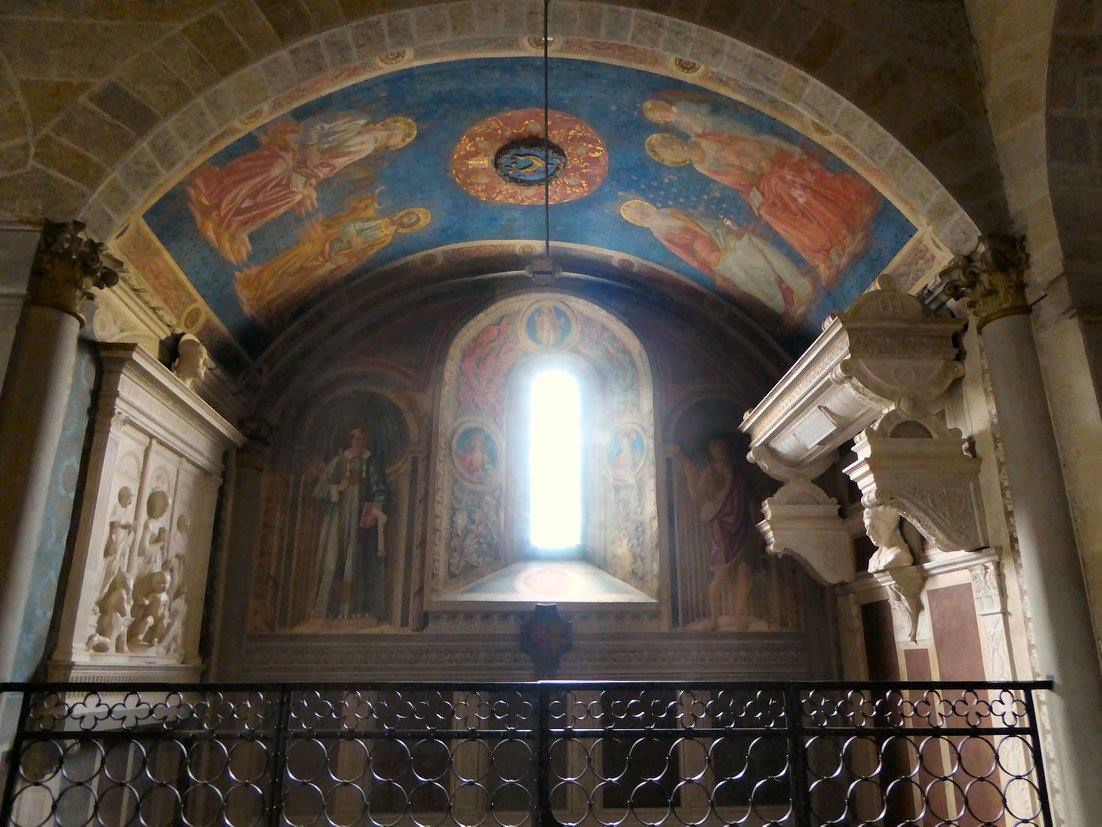
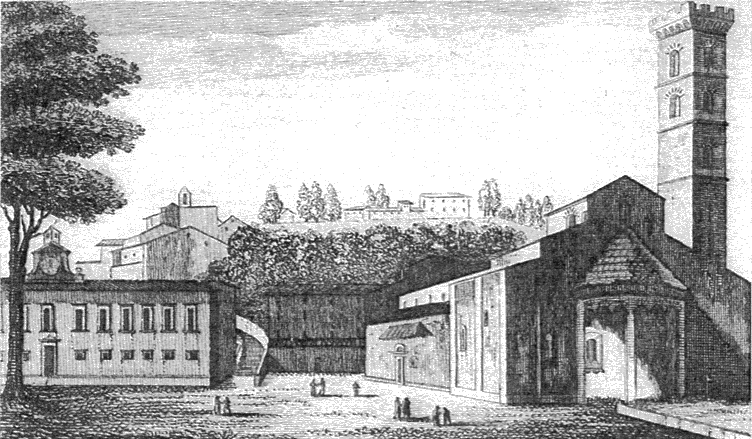
|
|
|
|
|
|
Badia
Fiesolana
Via dei Roccettini |
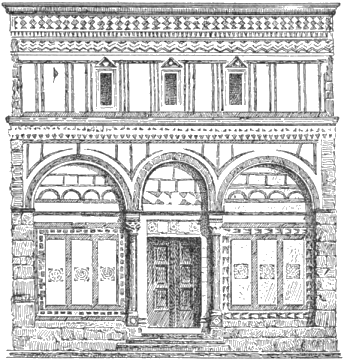 History History
The original abbey and Camaldolite convent was
rebuilt 1025-28 (rededicated to Saint Bartholomew) and, more drastically,
after 1439 when the complex was taken over by Augustinians. Up until
the 1025 rebuilding the church had been the cathedral of Fiesole,
dedicated to Saints Peter and Romulus, and said to have been built on the
site of Saint Romulus's martyrdom. The last rebuilding is what we see today,
with the only remainder of the first reconstruction being the Romanesque
polychrome marble section of the otherwise unfinished facade. The 15th-century work,
beginning in 1456, was funded by Cosimo de' Medici, who undertook to
rebuild the church, loggia, chapterhouse, cloister, dormitory and
sacristy. The work was given to Michelozzo's workshop and is, it
is said, to principles inspired by both Brunelleschi and Alberti. In 1520 the
complex was temporarily used as a hospice for sufferers from Florence’s
syphilis epidemic. Soon after this Charles V used it to house his troops during
the siege of Florence that he laid.
In later centuries the complex was used as a printing and
engraving shop and for housing. Today it is the home of the EU-funded European
University Institute, the church itself being used for the annual EUI conferring
ceremony and other events.
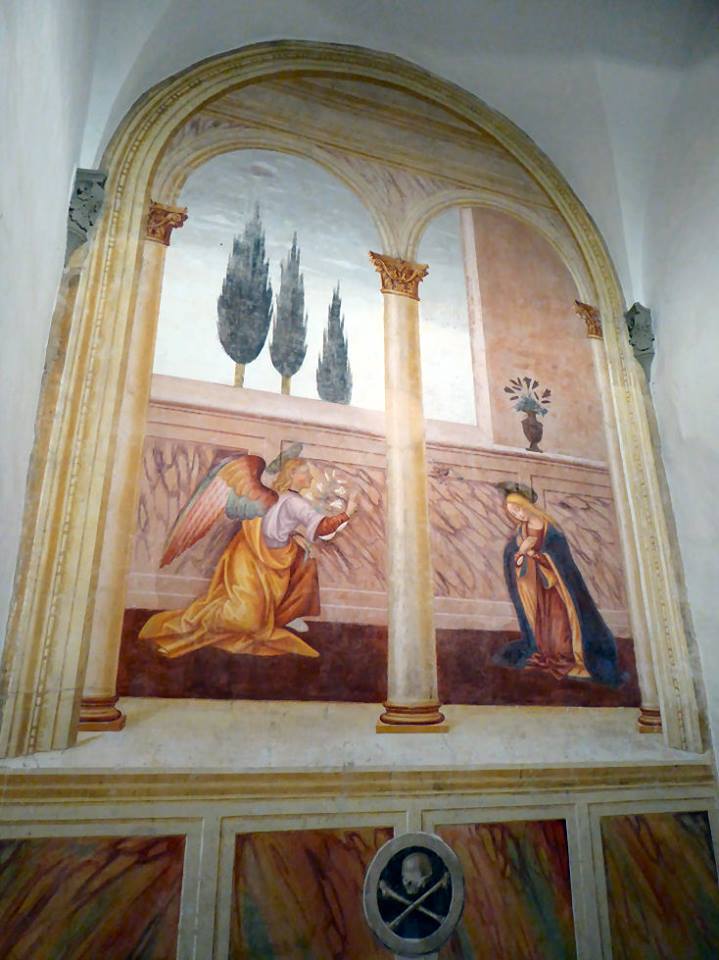
Interior
Very tall, barrel-vaulted and impressively bare, and thereby probably truer to Brunelleschi's
spirit than other of his churches with later embellishments. Four tall and deep square chapels either side of the single nave have
matching plain altars but a variety of contents. They are arched in
pietra serena by Francesco di Simone Ferrucci. One is totally frescoed,
the left hand ones have small windows but it was too dark on my visit to make out anything.
The baroque frescoed chapel has a bigger window.
Initially the north side
chapels were patronised by the Medici and the south side ones by the
families of their bank's directors.
The raised transepts have big
altars at each end, with a Crucifixion and a Resurrection? In a small
chapel off the left arm is a surprise (not mentioned in any guide book) large bright fresco of The
Annunciation (see left)
which the church claims is by Raffaellino del Garbo, but it's more likely
to be a workshop effort. The flat-ended choir is deep and also bare.
The library
Cosimo built a new library too, on the top floor of his rebuilding of the
complex. As he had at San Marco he employed the famed bookseller
Vespasiano da Bisticci to stock the
library. But unlike at San Marco here he was starting from scratch, so he
used the list of books in that library as his guide to the necessary
mixture of religious and classical works. Any not available second-hand
had to be created by the scribes and craftsmen employed by Vespasiano. The
200 books supplied where not all supplied by Vespasiano, but at
least nine of his were illuminated by an anonymous master called the
'Master of the Pear-Shaped Putti'.
Lost art
It was for Medici banker Angelo Tani's chapel here (the Chapel of Saint
Michael, first on the right)
that Hans Memling's Last Judgement Altarpiece (see right)
was commissioned, it being his first big commission. But it was famously
seized by Hanseatic pirates led by Paul Beneke on the 27th April 1473, on its way from Flanders to Florence.
The galley was boarded upon entering English waters, the Hanseatic League
being at war with England at the time. The painting was taken to Danzig
(now Gdansk) and installed on the altar of the Guild of Saint George in
the Marinkirche, from which it was looted by Napoleon. The sudden
attention and admiration it received in Paris has been argued as an
important stage in the rise in the reputation of 'primitive' Flemish
painting. The altarpiece was returned to Gdansk and there it remains.
During his rebuilding work in the 15th century
Cosimo de' Medici also gave no-expense-spared work to bookseller
Vespasiano da Bisticci to stock the library, employing forty-five scribes
to provide two hundred volumes. Most of them where transferred to the
Biblioteca Laurenziana in 1778.
Opening times
Monday - Friday 9.00 - 5.30
Saturday 9.00 - 12.00
|
|
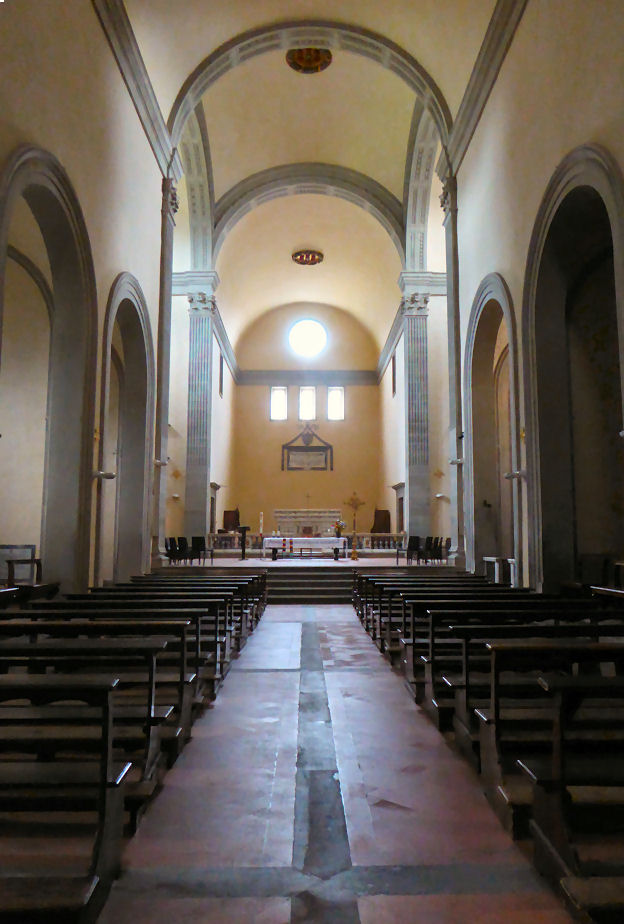
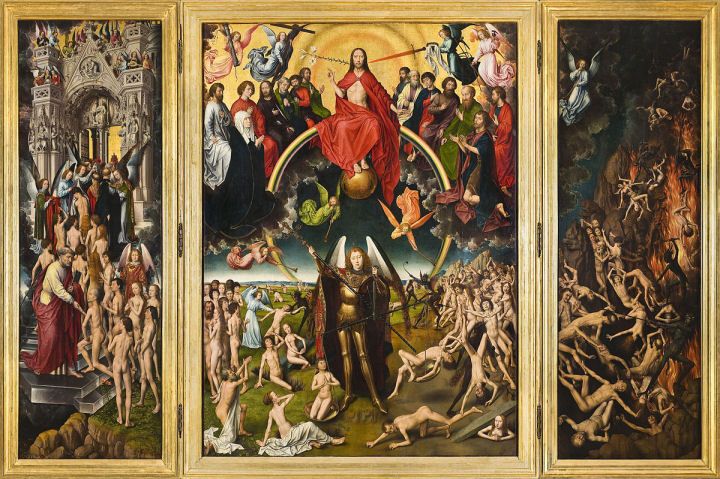
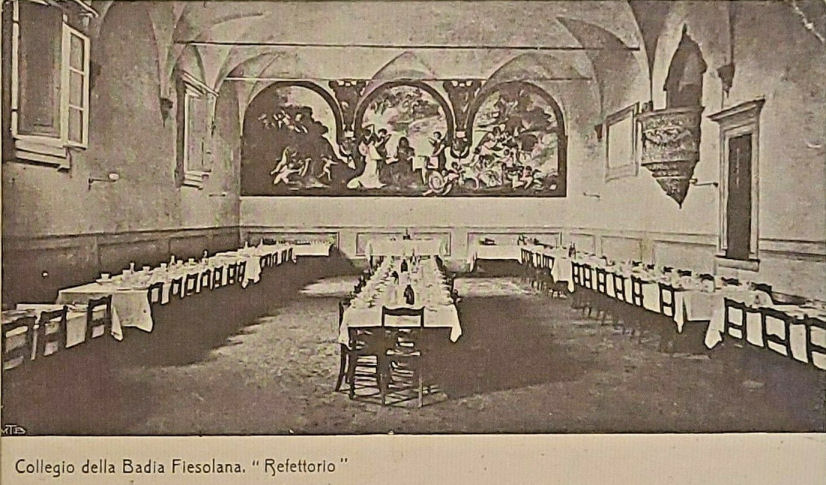
|
|
San
Domenico
Piazza San
Domencio |
|
History
Built from 1406-35 for Observant Dominicans and
founded by Giovanni Dominici, a busy Dominican diplomat during the Papal
Schism, whose preaching was described as 'like hearing Saint Francis
reborn'. This was the second Dominican convent in Florence, after Santa Maria Novella
and before San Marco, being consecrated on 25th October 1435. Pope
Eugenius IV had been in town, but his retinue would not have fitted
in the small church.After being
founded in 1406 by Giovanni Dominici the complex had been abandoned in 1409 due to political
machinations around the Schism, with the friars not returning until 1418. The
church was lengthened and the interior remodelled in the 15th and 16th
centuries based on the Badia in Florence, with the portico of 1635 and a
campanile in 1611-13 added by Matteo Nigetti.
This was the convent Fra
Angelico first entered, around 1421, possibly at the suggestion of
Leonardo Dati, who he would have met while working in Santa Maria Novella.
Born Guido di Pietro around
1395 in the Mugello, and known as Fra Giovanni da Fiesole whilst he was here, he joined with his
younger brother Benedetto and moved to San Marco around
1436. He returned (from Rome) in 1449 when he was elected prior here.
Much of the
convent today houses the European University Institute which is based up
the hill in the Badia complex, but a few monks remain.
The chapter house next door (ring bell no.4 to the right of the church
portico) contains a fresco of The Crucifixion (c.1430) by Fra
Angelico, along with a fresco (and its sinopia) of the Virgin and
Child originally a lunette in the cloister, also said to be by him.
The Crucifixion emerged from its most recent, and long,
restoration in June 2025. It had been whitewashed, probably in 1566, along
with the rest of the wall, before being being rediscovered in 1880 by
Father Raimondo Magrini,
To
the left of the portico is the entrance to a nice little cemetery with
some odd and interesting stones and tombs.
Interior
Small and tall with three pietra serena arched deep chapels on each side.
The first two on each side were built 1488-95, with the last pair the
Annunciation chapel on the left and Saint Anthony's chapel on the right,
built in 1559 and 1592 respectively. Those on the left are connected and the first contains the highlight Fra Angelico
(see below) Also on this
side are an Epiphany by Sogliani and a rather handsome
and tastefully Mannerist Annunciation by Jacopo da Empoli. The
chapels opposite contain a Crucifixion attributed to Jacopo del
Sellaio and a Baptism of Christ by Lorenzo di Credi. The ceiling's
trompe
l'oeil frescoing is somewhat out of keeping.
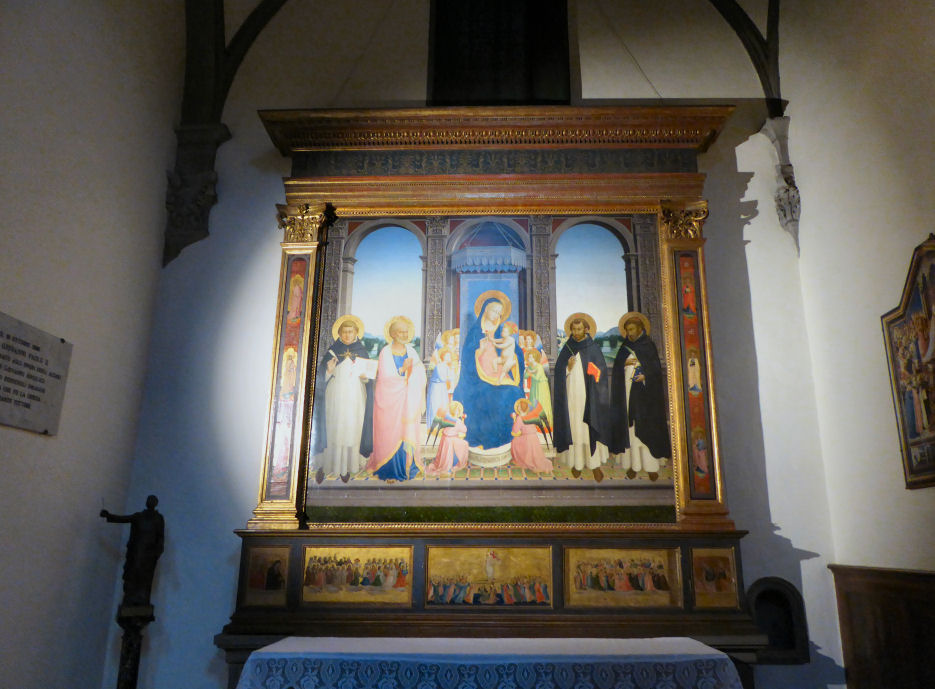
Art highlight
An altarpiece, sometimes called The Fiesole Altarpiece, or
The San Domenico Altarpiece, was
made around 1422 for the high altar here by Fra Angelico, one of three he
painted for the church here (see Lost art below). It was removed
from the high altar in 1610 and is now in the first chapel on the left (see
above). It
is thought to be his first altarpiece. It shows the
Virgin Enthroned handing a white and a red rose to the naked Christ, these flowers symbolising purity and the
Eucharist. She is surrounded by
angels with three Dominican saints in black and white robes (Dominic de
Guzman,
Thomas Aquinas and Peter Rosini (the Martyr)) with Saint Barnabas at
her right hand, to honour Barnaba degli Agli, the patron, a Florentine
merchant who funded the convent's reconstruction and the triptych. If it looks odd and too tall is because
it was painted as a late-gothic gold-ground triptych and was altered in
1501 when it was enlarged at the top, the sky, background landscape and
architecture was added by Lorenzo di Credi and the multi-compartmental
arched framing was removed. He
also repainted most of the costumes. The work was respectfully done but
results in an altarpiece that looks a bit...wrong. For a reconstruction of the original
form see right.
The saints now here in the
pilasters were taken from another altarpiece by Lorenzo di Bicci.
The five mind-bogglingly populous predella panels show
Christ Glorified in the Court of Heaven flanked by The Virgin with
the Apostles, Doctors of the Church and Monastic Saints in the panel
on the left and The Forerunners of Christ with the Martyrs and Virgin
in the panel on the right. In the pilasters are Eighteen Blessed
of the Dominican Order, on the left, and Seventeen Blessed of the
Dominican Order and Two Dominican Tertiaries. These panels in the
church are copies by Michele Micheli,
a forger who helped to arrange the sale of Fra Angelico's originals around
1827. The originals are now in the National Gallery in London, having been
first bought by Nicola Tacchinardi, an opera singer favourite of Rossini.
Lost art
Many works by Fra Angelico: A Crucifixion with Saint Dominic fresco from the
refectory here and two panels depicting adoring angels, very worn, are in
the Louvre. These panels may have been part of the shutters of a ciborium
mentioned by Vasari now in the Hermitage. Also in the Hermitage is a
fresco depicting the Virgin and Child with Saints Dominic and Thomas
Aquinas (see below right).
Angelico's three major works, though, began with the high altarpiece
discussed above. The
other two are the Annunciation in the Prado (painted next) with
scenes from the Life of the Virgin in the predella, and a pastelly Coronation of
the Virgin (with very colourful steps) in the Louvre, which has
perspective-dominated scenes from the Life of Saint Dominic in the
predella. This altarpiece was judged by Vasari to be the best of the
three. The
Annunciation and Coronation altarpieces would originally have been on altars either side
of a rood screen (left and right of the entrance, respectively) facing the congregation and were also both
probably painted under the patronage of Taddeo di Angelo
Gaddi, the great-grandson of the painter Taddeo. Both where looted by
Napoleon. The Prado Annunciation recently underwent considerable
conservation and study for the major 2019 Fra Angelico exhibition in that
gallery.
The predella for the altarpiece that's still here is in the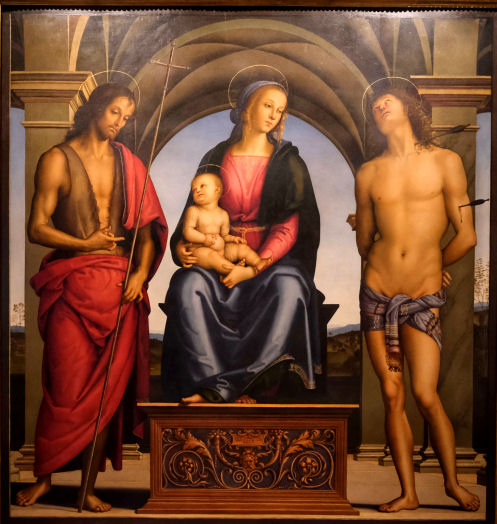 National Gallery,
acquired by 1860, and four standing
saints from the side pillars of the earlier frame are in Chantilly (Saints Mark and
Matthew, probably studio works) and the Rau Collection in Remagen (Saints
Nicholas of Bari and Michael). The roundels of the
Annunciation in the pinnacles are in a private collection. Roundels of
Saints Romulus and Alexander from the tops of the pilasters
are in The London National Gallery and the Met respectively. National Gallery,
acquired by 1860, and four standing
saints from the side pillars of the earlier frame are in Chantilly (Saints Mark and
Matthew, probably studio works) and the Rau Collection in Remagen (Saints
Nicholas of Bari and Michael). The roundels of the
Annunciation in the pinnacles are in a private collection. Roundels of
Saints Romulus and Alexander from the tops of the pilasters
are in The London National Gallery and the Met respectively.
Pietro Perugino's 1493 Virgin and Child
Enthroned, with Saints John the Baptist and Sebastian (see right) was
painted for the chapel of Cornelia, wife of Giovanni Martini Salviati, here (now the Guadagni Chapel)
but is now in the Uffizi. The face of the Virgin is said to be a portrait
of Chiara Fancelli, the daughter of architect Luca Fancelli, who Perugino
had married the same year.
Opening times
7.30 - 12.30 & 4.30 - 6.30
(8.30 - 12.00 & 4.00 - 6.00
in winter)
|
|
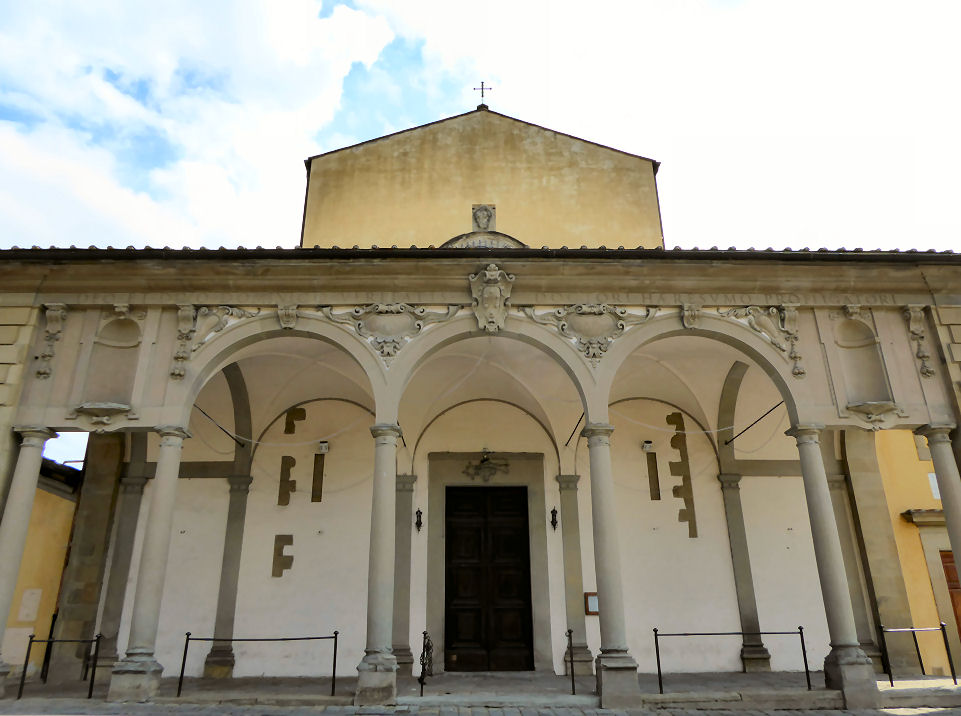
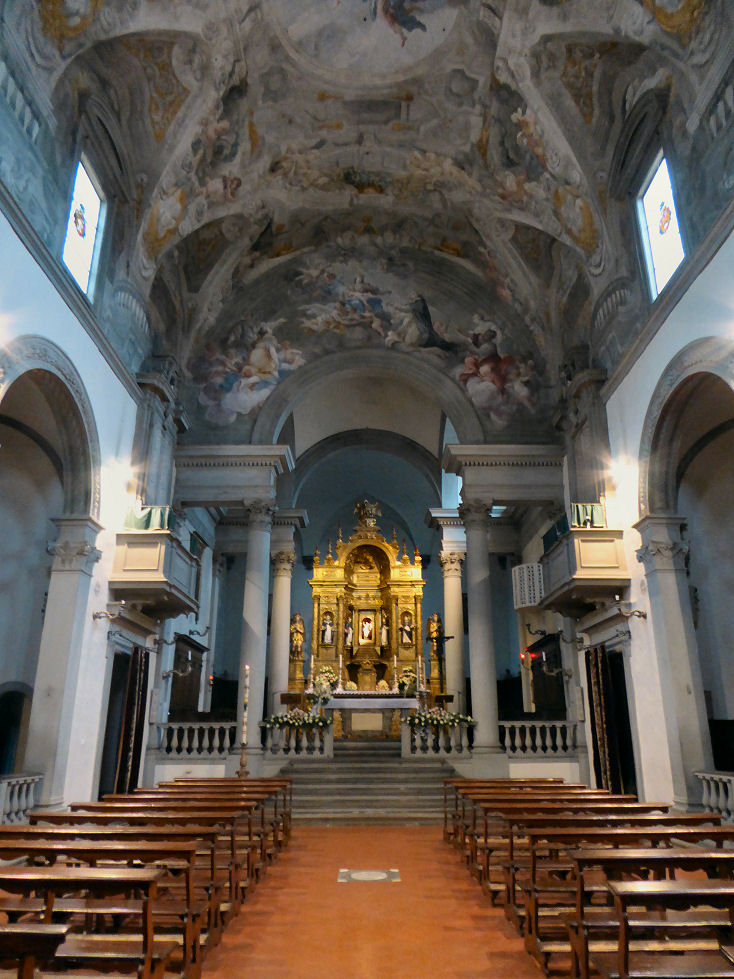
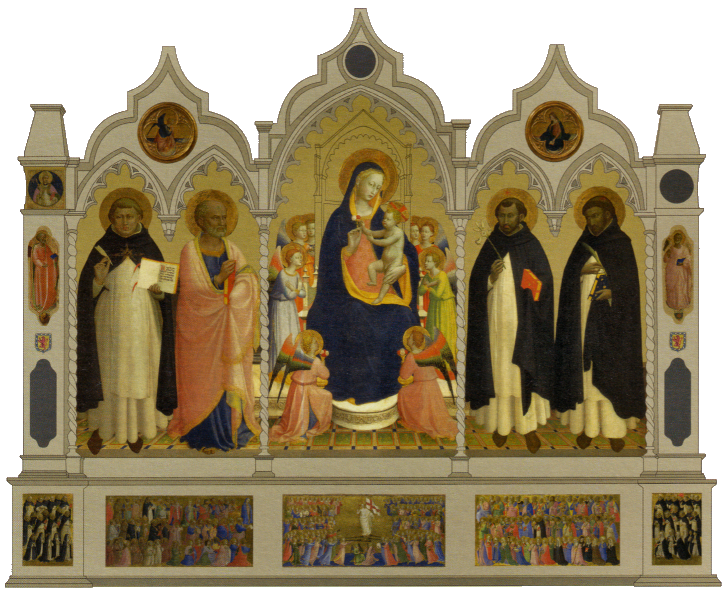
A reconstruction of the original form of Fra
Angelico's Fiesole Altarpiece
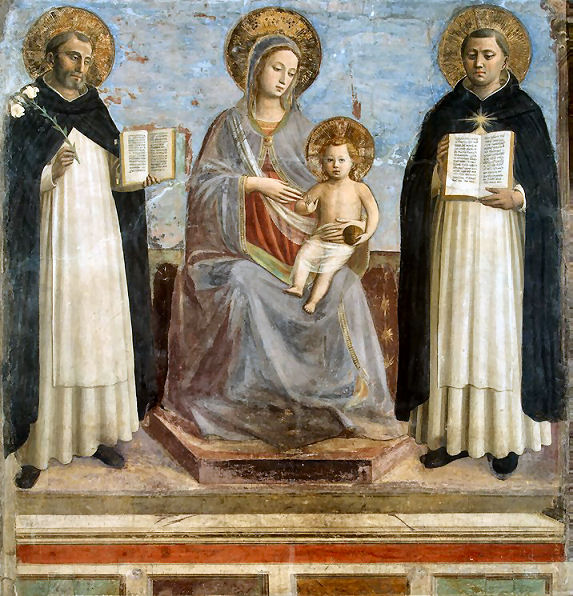
|
|
San
Francesco
Via
San Francesco |
History
Built on the site of an Etruscan, and then Roman, acropolis, the church
of St Mary of the Flowers was built here for a small order of Florentine
women called the Recluses of St Alexander (named for the nearby church).
They established themselves here in 1333 and had a small gothic church
built by Lapo di Guglielmo Pollini the year after. In 1352 they moved out,
to Pietrafitta on the Mugnone river. A papal bull establishing a
Franciscan convent here was issued in 1399 and from that date on the
church was enlarged and its dedication was changed. Considerable regrettable
rebuilding from 1600 was followed by heavy restoration in 1905-7, which
resulted in neo-gothic heaviness at the expense of the renaissance charm,
but the cloisters retain this.
Interior
A small gothic-arched space heavily restored in the 20th
century with two pairs
of ornate altars before the low balustrade dividing the body of the church from
the deep choir. The triumphal arch is said to be the work of Benedetto da
Milano from the period of Franciscan rebuilding.
On the first right-hand
altar is a Mystic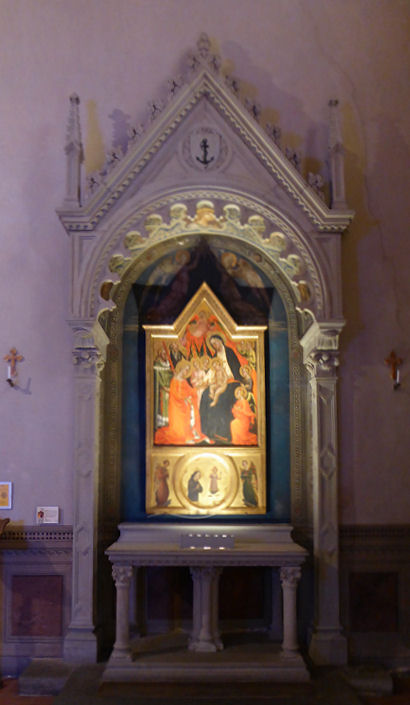 Marriage of Saint Catherine by Cenni di Francesco (see
left). The panel depicting St Anthony of Padua below it is said to be
by one of the sisters of St Mary. There's (currently a photo of) an
Immaculate Conception by Piero di
Cosmo over the second
altar. The barrier of the balustrade means you can only get a distant view of
the high altarpiece Crucifixion by Neri di Bicci. On the left-hand
side altars are an Adoration of the Magi by the school of Cosimo Rosselli and a highlight
Annunciation by Raffaellino del Garbo, formerly placed on the high
altar. Also a Bicci di Lorenzo triptych placed on the wall here in 1998, a
Virgin and Child Enthroned with Saints. Marriage of Saint Catherine by Cenni di Francesco (see
left). The panel depicting St Anthony of Padua below it is said to be
by one of the sisters of St Mary. There's (currently a photo of) an
Immaculate Conception by Piero di
Cosmo over the second
altar. The barrier of the balustrade means you can only get a distant view of
the high altarpiece Crucifixion by Neri di Bicci. On the left-hand
side altars are an Adoration of the Magi by the school of Cosimo Rosselli and a highlight
Annunciation by Raffaellino del Garbo, formerly placed on the high
altar. Also a Bicci di Lorenzo triptych placed on the wall here in 1998, a
Virgin and Child Enthroned with Saints.
The door on the left gives access to the sacristy, cloisters and museum.
The museum has a somewhat ramshackle collection of Egyptian and Chinese
objets collected by missionaries.
The square
In front of the church, the building that is now the shop was built in
1625 as a chapel dedicated to Saint Bernard, a saint very venerated in
Florence. Various functions followed,
before it was comprehensively restored in 1962. The loggia opposite was
restored in 1931-3.
Opening times
9.00 - 12.00, 3.00 - 6.00 (7.00 April-September)
|
|
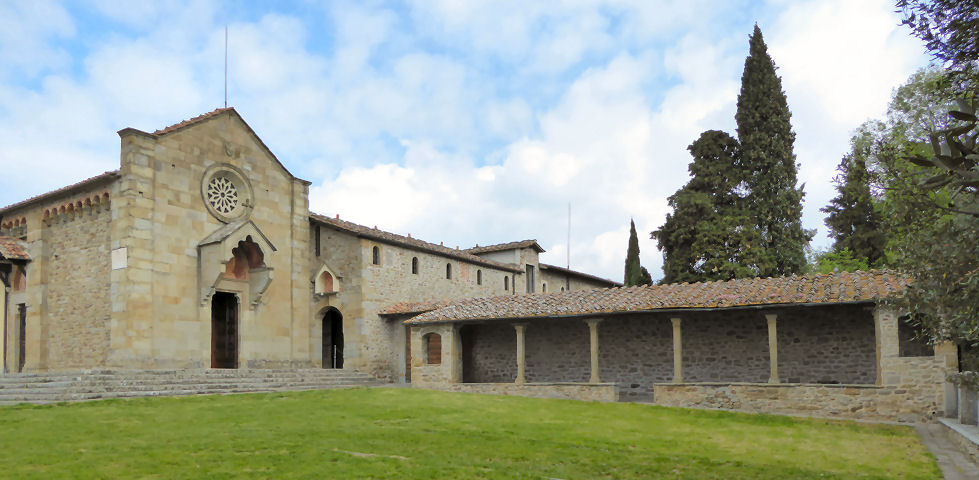
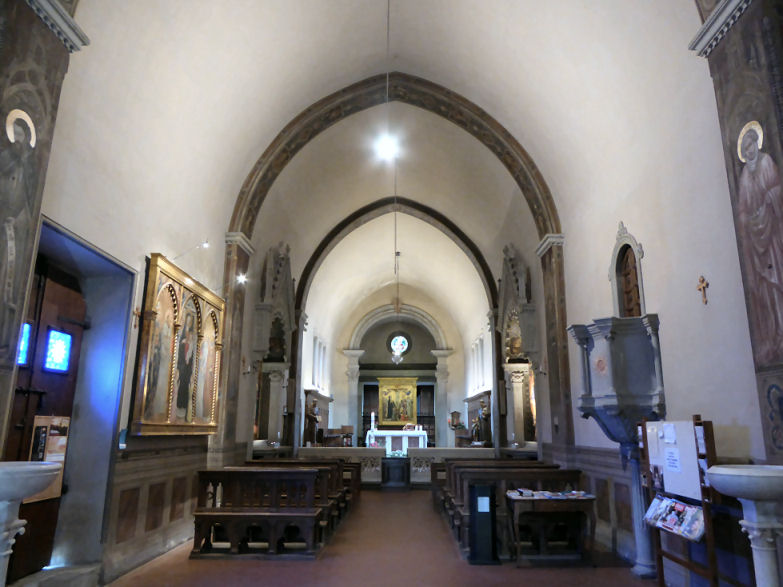
|
|
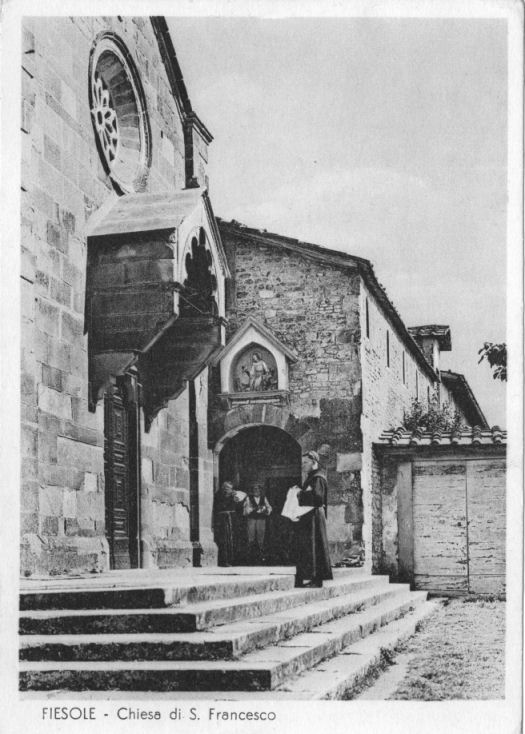
|
|
San Girolamo
Via Vecchia
Fiesolana |
|
History
A church is said to have been built here, possibly as early as the 10th century,
dedicated to Saint Jerome. It was built on the site of the martyrdom by
beheading of Saints Dulcissimus, Carissimus, Crescentius and Marcitianus under
Nero, or maybe Domitian. They were companions of Saint Romulus, the first bishop of
Fiesole, whose martyrdom was also said to have begun here, and ended down near
San Domenico. A stone near the entrance gate marks he spot. No written record
exists, however, to date this church earlier than 1360, when the blessed Carlo dei Conti Guidi di Montegranelli came here to find solitude after a military
career. He then founded the Eremiti di San Girolamo (The Order of the Hermits of
Saint Jerome, or Hieronymites) in 1380, receiving papal confirmation in 1404 and
1415, with the help of Saint Antoninus, later Archbishop of Florence.
With the patronage of Cosimo de' Medici, whose villa was very nearby, the complex was
rebuilt between 1445 and 1451 by Michelozzo for
Cosimo de' Medici, preserving the old chapel and cells. More remodelling to the monastery followed in the 17th century,
with the church's choir stalls replaced, but these sold in the early 20th
century. In 1633 a new loggia was added to the church, built by Matteo Nigetti
for Alexander and Anthony, converted Jews from a wealthy family who had been
adopted by the Medici family. In 1661 a new high altar was built by the Guadagni
family, which is long gone. In 1668 the Order of the Hermits of Saint Jerome was
suppressed, the complex passed into private hands and the church, which was not
part of the sale was stripped of its art and fittings by later owners from the
Riccasoli family, it is said, who bought it from the Bardi.
From 1889 the complex, by now known as the Villa San Giralomo, was run by nuns
of the Little Company of Mary, known as the Blue Nuns from their blue and white
habits, a nursing order of Irish nuns founded by Mother Mary Potter in 1877 in
Nottingham. The
villa was originally run as a nursing home and later branched out into providing room and board
to pilgrims and students. But they were shut down in 1998 by the mayor of Fiesole, who accused the nuns of running an unauthorized hotel.
They sold the complex which is now privately-owned.
The church
Art includes a
fresco of Saint Jerome by Luigi Sabatelli. The high altar, designed
by Nigetti in 1661, has an altarpiece by Giovanni Domenico Cerrini of the
Assumption of the Virgin. In the floor are the porphyry tomb of
Francesco del Tadda and the circular marble tomb of Girolamo di Piero di
Cardinale Rucellai (see
Lost art
below) of 1478. There is talk of 15th-century
frescoes revealed by scraping off whitewash and an old Annunciation, now
in the sacristy.
Lost art
An altarpiece of c.1490 by Francesco Botticini,
called the San Girolamo Altarpiece (see right) which once stood on
the first altar on the left here, is now in the National Gallery in London.
Jerome, in a separately framed image, is flanked by
Saints Eusebius (a friend of Jerome) and Damasus (the pope who commissioned
Jerome to translate the Bible into Latin) on the left, with Saints Paula and Eustochium, the
Roman noblewoman and her daughter, on the right. The latter were both followers and
helpers of
Jerome who became successive abbesses of a nunnery founded in Bethlehem. The
altarpiece was commissioned by the Florentine
patrician Girolamo di Piero di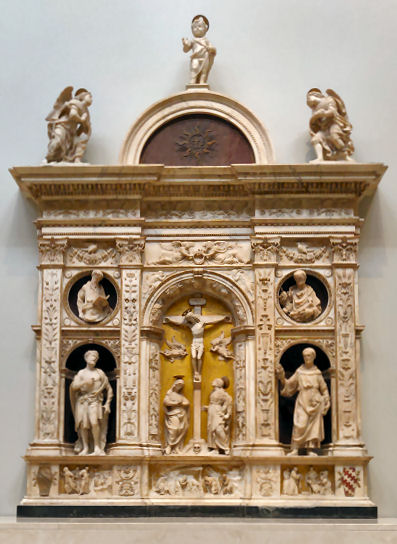 Cardinale Rucellai, the left-hand praying donor
figure, whose circular marble tomb,
like the one in the altarpiece, can still be seen in the church. The other
kneeling donor is his son. Rucellai coats of arms are at the ends of the
predella and their impresa (family emblem), a diamond ring interwoven
with flowers, is carved on the frame. The predella shows four scenes from the life of Jerome. Cardinale Rucellai, the left-hand praying donor
figure, whose circular marble tomb,
like the one in the altarpiece, can still be seen in the church. The other
kneeling donor is his son. Rucellai coats of arms are at the ends of the
predella and their impresa (family emblem), a diamond ring interwoven
with flowers, is carved on the frame. The predella shows four scenes from the life of Jerome.
A sacrament tabernacle from c.1480-97, also commissioned
by Rucellai for his altar, is now in the Victoria and Albert Museum in London,
as is an enormous marble altarpiece, both
being by Andrea di Pietro Ferrucci. The
latter (see right) was commissioned in 1493 by Tita di Roberto Salviati to be placed above her and her
Venetian husband Girolamo Martini's tomb. The coats of arms of her and her
husband decorate each end of the predella.
A Medici-commissioned altarpiece attributed to Zanobi Strozzi, made for this
church c.1463-5 and depicting The Virgin and Child with Saints Cosmas,
Damian, Jerome, John the Baptist, Francis and Laurence, is in Avignon.
Moroni reports a Ghirlandaio Virgin and Child with Medici donors over the
first altar on the right, but he doesn't mention the Strozzi, so this might be a
mix up.
Opening times
None - the complex is now gated private apartments.
Bibliography
San Girolamo Fiesole Acquapendente 1928
The source of many facts here and the black and white images.
|
|
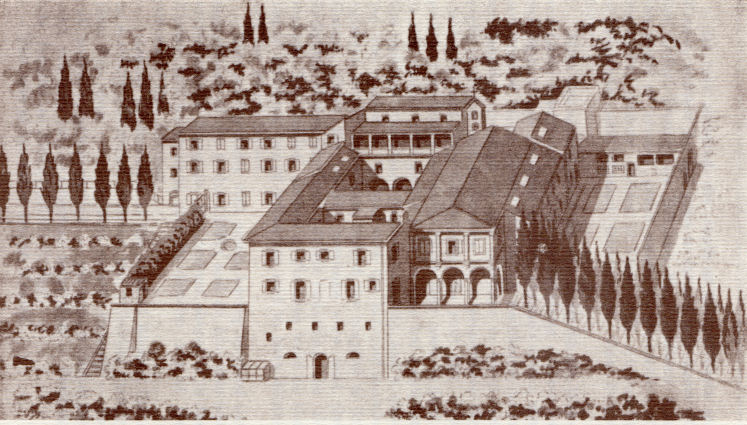
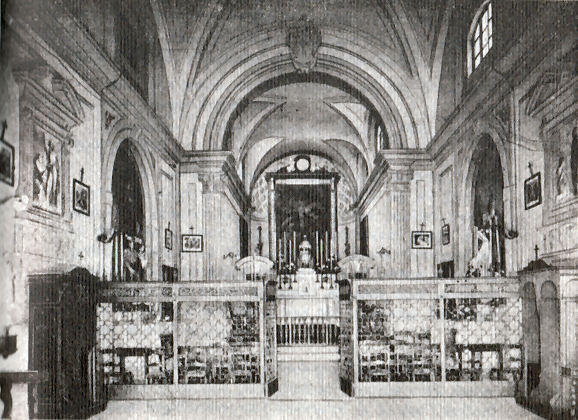
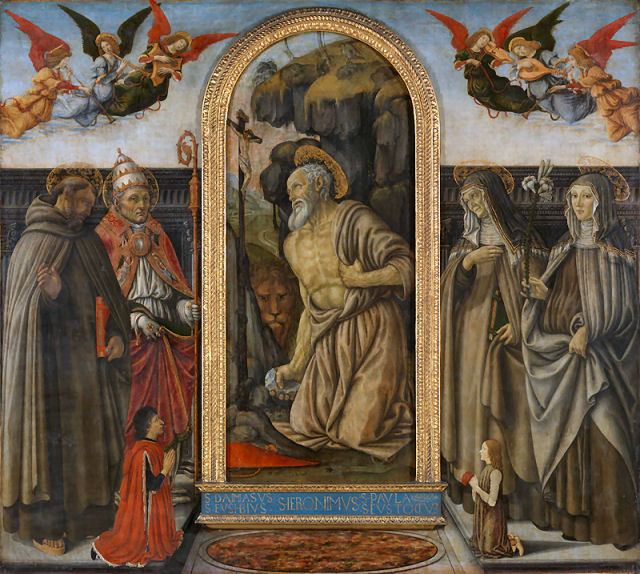
|
|
Sant’Alessandro
Via
San Francesco |
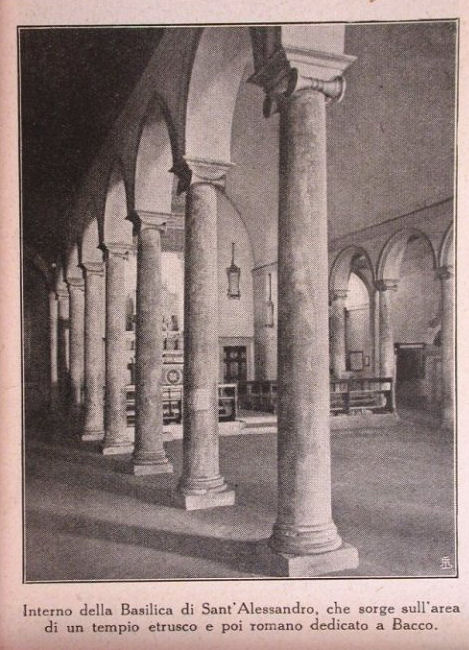 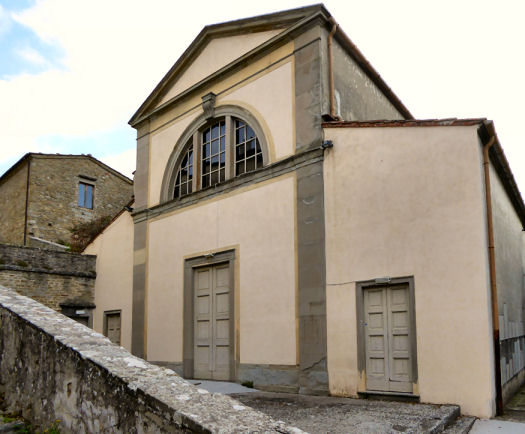
History
Said to have been built on the site of an Etruscan temple, this church was
probably founded in the 6th century, making it the oldest church in
Fiesole. It was initially dedicated to St Peter but in 820 this was
changed to St Alexander, a Bishop of Fiesole drowned near Bologna in 590
after challenging incursions into church matters made by the rulers of
Lombardy. His remains are behind the altar. Much destructive rebuilding
was carried out here in the 19th century.
Interior
The bare basilical interior has 15 cipollino marble columns, 8 each side*,
with ionic capitals and bases recycled from a roman building.
A chapel on the left contains renaissance frescoes depicting The Birth
and (Early) Life of Christ. The sacristy (to the left) has access
below the church to ancient remains and mural paintings.
Opening times
Sometimes open for exhibitions.
*I know that 2x8=16, but until I find out if this is just bad maths...or
that maybe one of columns is made of something else.
|
|
Santa Maria
Primerana
Piazza Mino da Fiesole |
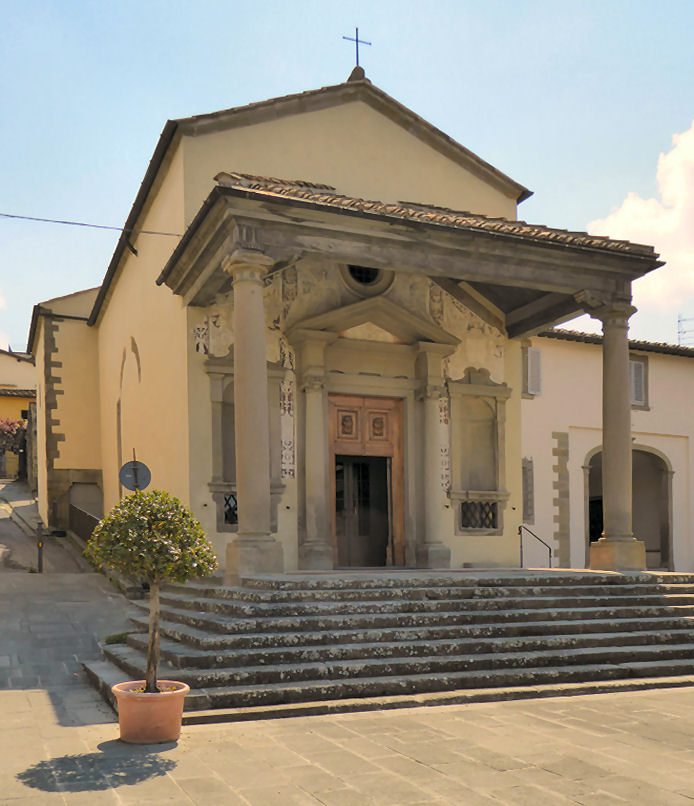 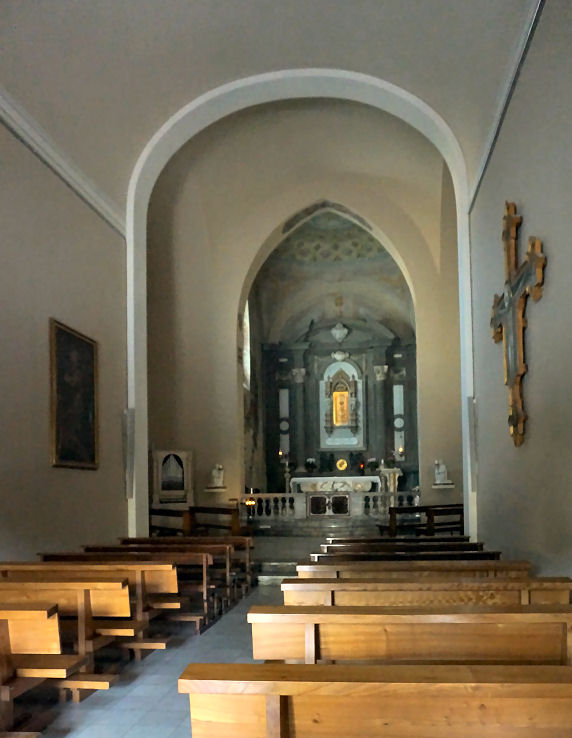
History
Built on the site of an ancient oratory, it is said,
first mentioned in 966 and itself built on a Roman temple. Rebuilt in the 16th/17th centuries, the facade was built
in 1585, with the portico dating to 1801. The church was restored in 1948.
Interior
Plain and tall and aisleless, the body of the church is dark and contains a few ordinary panels
and copies, along with a painted Crucifix from c.1350 (restored in 2008
for a Uffizi exhibition L'eredità di Giotto) on the right wall, opposite an old column embedded in the
wall on the left. The apse is brighter and has admirable frescoes. On the left
is a damaged Nativity of the Virgin by Niccolò di Pietro Gerini and on
the right a more vivid Presentation at the Temple by the 'school of Taddeo
Gaddi', as the printed guide in the church tells us. The frescoes on the left
were discovered during the 1948 restoration work. In the tabernacle behind the
18th-century altar is a locally revered Virgin from around 1255. There's
a glazed terracotta Crucifixion in the left hand wing of the transept by
the workshop of Andrea della Robbia, the nephew of Luca, and a bas-relief self-portrait head
in the right hand wing by Francesco da Sangallo (1494-1576) and another by him
of Francesco del Fede, of 1575.
|
|
|
Fontelucente
Named for a local spring known from
at least the 15th century, an oratory was built here. Inside is a
triptych by Mariotto di Nardo from 1398 of the Madonna della Cintola.
|
|
San Martino di Mensola
Up Via Dupre, side of the Bandini
Sant'Ansano oratory
Via
Vecchia Fies
Lost art
Lorenzo Monaco's Crucifixion, with the Virgin and Saints John the Evangelist
and Francis now in the Museo Bandini.
|
|

home
Centre
::
East ::
West ::
Oltrarno ::
Fiesole
Siena
†
Pisa
|
 History
History
 Marriage of Saint Catherine by Cenni di Francesco (see
left). The panel depicting St Anthony of Padua below it is said to be
by one of the sisters of St Mary. There's (currently a photo of) an
Immaculate Conception by Piero di
Cosmo over the second
altar. The barrier of the balustrade means you can only get a distant view of
the high altarpiece Crucifixion by Neri di Bicci. On the left-hand
side altars are an Adoration of the Magi by the school of Cosimo Rosselli and a highlight
Annunciation by Raffaellino del Garbo, formerly placed on the high
altar. Also a Bicci di Lorenzo triptych placed on the wall here in 1998, a
Virgin and Child Enthroned with Saints.
Marriage of Saint Catherine by Cenni di Francesco (see
left). The panel depicting St Anthony of Padua below it is said to be
by one of the sisters of St Mary. There's (currently a photo of) an
Immaculate Conception by Piero di
Cosmo over the second
altar. The barrier of the balustrade means you can only get a distant view of
the high altarpiece Crucifixion by Neri di Bicci. On the left-hand
side altars are an Adoration of the Magi by the school of Cosimo Rosselli and a highlight
Annunciation by Raffaellino del Garbo, formerly placed on the high
altar. Also a Bicci di Lorenzo triptych placed on the wall here in 1998, a
Virgin and Child Enthroned with Saints.


